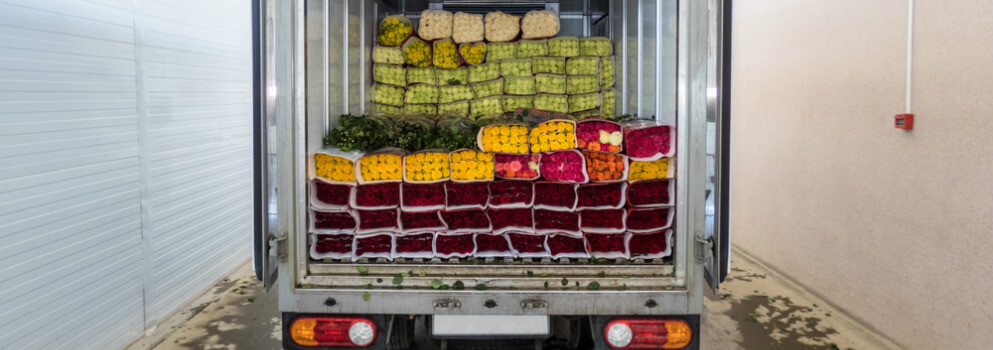
HOW TO TRANSPORT FLOWER ARRANGEMENTS – FLOWER TRANSPORT COOLING TIPS
Worldwide, flowers are enjoyed for their distinct patterns, sensuous smells, and vibrant colors. These natural delights have been arranged in various ways to adorn both commercial and residential building interiors as well as form an integral part of shared gifts on various romantic and symbolic holidays.
In a lot of instances, cut flowers must be transported over long distances, even across continents to reach diverse floral markets. This poses a significant challenge in terms of storage and preservation of freshness.
So, how are flowers shipped in a way that accommodates preservation? This article will discuss vital cooling tips to ensure cut flowers are preserved in an ideal state for as long as possible.

Important Factors for Effective Flower Transport
Various factors determine the shelf life of cut flowers once connections have been severed with their source plants. Considering these factors is especially important when the cut flowers must be moved over long distances via air or road transport vehicles.
Temperature
A clear link has been established between plant respiration, ambient temperatures and the aging of cut flowers. Like every other plant, cut flowers undergo respiratory processes that generate substantial amounts of heat.
While this heat is easily dissipated in an open environment, storage and transport in sealed packages means this thermal energy is maintained around the flowers. Retained heat will dramatically increase the rate at which the cut flowers respire, generate more heat and hence set up a harmful thermal cycle.
It is vital that floral transporters consider cooling systems when moving flowers as the result of persistently elevated temperatures is a faster onset of aging and diminished shelf life.
Hydration and Humidity
Another key determinant of how flowers are shipped is the presence of adequate hydration and environmental humidity. For maximum longevity, cut flowers require ambient humidity to be around 90% – 95%. These plants are particularly prone to rapid water loss when severed from their nutrient-rich roots and will require proper rehydration to retain their freshness.
Immersing the flower stems in clean water will promptly restore water balance as long as there is no impediment to the free flow of water through them. The presence of air bubbles or bacteria in cut plant stems as well as the use of contaminated water, are concerns that need to be addressed to maintain satisfactory flower hydration.
Ethylene Inhibition
When deciding how to ship floral arrangements, it is vital that an ethylene-free packaging process is used. Ethylene gas has a particularly damaging effect on most flower species causing flower death or wilting. Some rose cultivars, carnations and delphiniums are particularly sensitive to even small concentrations of ethylene.
Ethylene gas, which is generated by plant respiration, fruit ripening and burning of organic materials can be eliminated by the use of various inhibitors including the under listed methods.
- Silver thiosulfate complexes
- Gas-based ethylene inhibitors
- Refrigerated floral storage units
When used properly, these measures will prolong the storage duration and shelf life of cut flowers.
Carbohydrate Retention
Carbohydrate sugar stores within the flower stems are responsible for providing energy to flowering plants. When these flowers are cut, there is a higher tendency for these stores to decline rapidly leading to wilting and death.
To prevent this undesirable occurrence, cut flowers may be exposed to a sugar-containing solution for a short duration (less than 24 hours) immediately after cutting. This process is known as “pulsing” and helps boost energy stores which translates to longer shelf life.
Disease Prevention
Flowers are very susceptible to disease, especially fungal infections. A commonly implicated pathogen, gray mold, will develop on moist flowers and damage their petals thus diminishing their aesthetic value. The use of fungicidal sprays and dips have been shown to effectively preserve flowers intended for long-distance transportation.

What Does a Floral Transport Delivery System Look Like?
For the distribution of flowers, the best most effective method takes into consideration the various factors that can adversely affect flower quality. An effective floral delivery system ensures the freshness of cut flowers is retained up to the end consumer point.
Cooling
Cooling systems are vital to keeping flowers at optimal temperatures and delaying aging processes. Various florist chillers are available to reduce the heat generated by both plant respiration and ambient temperature fluctuations.
Transportation
For sturdier flowering plants, cut pieces are typically transported in flat boxes. These boxes allow more items to be transported in smaller spaces within aircraft and other transport vehicles.
In some cases, the flowers are rather delicate and must be not be kept out of the water from extended periods. In these instances, the flowers must be transported with their stems suspended in water vases. While this will preserve the flowers for longer, the cost of transportation will rise significantly due to the added weight of the water and transport containers.
Distribution
The distribution of cut flowers can be done directly to the consumers or through various intermediaries. If the delivery is to a local customer, growers may cut selected flowers and deliver directly. However, if the intended customers are located far from the growers, then the flowers will be shipped to wholesalers or florists who repackage them into bouquets for onward delivery to customers.
Cold Shot Chillers Has the Florist Chillers Your Transport System Needs
For more than three decades, Cold Shot Chillers has continued to provide top quality industrial chillers and cooling solutions to its clients. We remain dedicated to manufacturing high-quality air-cooled water chillers that are suited to various industrial applications including medicine, metalwork and flower-growing operations.
Please contact us today for more information about our chiller systems or to request a quote.